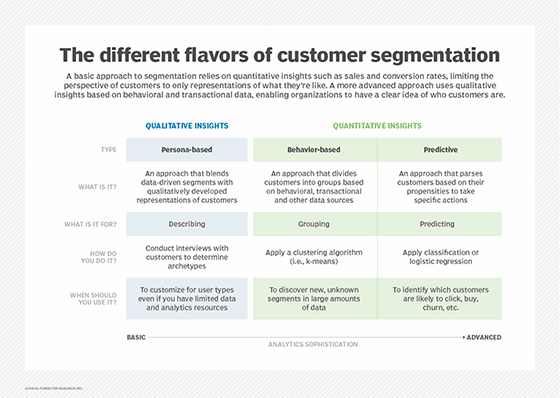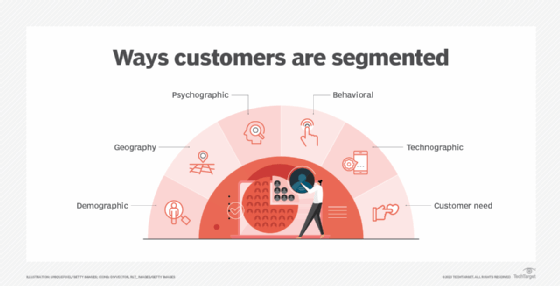
customer segmentation
What is customer segmentation?
Customer segmentation is the practice of dividing a customer base into groups of individuals that have similar characteristics relevant to marketing, such as age, gender, interests and spending habits.
Companies employing customer segmentation know that each customer is different and that targeting all their customers with one approach isn't effective. Instead, the organization's marketing efforts would be better served if they target specific, smaller groups with messages those consumers find relevant.
The goal of customer segmentation is to reach out to customers more effectively, thereby leading to more sales or customer conversions. Companies also hope to gain a deeper understanding of their customers' preferences and needs by discovering what each segment finds most valuable and more accurately tailoring marketing materials toward that segment.
Customer segmentation relies on identifying key differentiators that divide customers into groups that can be targeted. Information such as a customer's demographics, geography, psychographic and behavioral tendencies are taken into account when determining customer segmentation practices.

Types of customer segmentation
Customer segmentation can be done in several ways. For example, customer groups can be narrowed down to who the customers are and what they do or expanded to include more precise segments -- with each type having more granular factors.
For example, customer segmentation can include the following segments:
- Demographic. This includes factors such as age, race, religion, gender, family size, ethnicity, income and education level.
- Geography. This includes residing countries, states, cities and towns.
- Psychographics. This includes social class, values, interests, lifestyle and personality characteristics.
- Behavioral. This includes tendencies, habits, spending, product usage and desired benefits.
- Technographic. This includes mobile, desktop, software and application use.
- Customer need. This includes requirements for a product or service for different customer groups.
The segments an organization uses can vary depending on its size and industry, and different segmentation approaches should be used based on this.

Customer segmentation procedures
Organizations can use the following techniques to pursue customer segmentation:
- Decide what data to collect and how to gather it. Segment data is collected through either direct or indirect methods. Direct collection involves customer surveys, while indirect methods are insights gained from data that isn't directly obtained but can still aid in understanding potential customers, such as through social listening. Customers can also be segmented using predictive factors.
- Develop methods of data analysis for segmentation. Methods of segmentation should focus primarily on a customer's experience as opposed to only demographic factors.
- Establish effective communication among relevant business units about the segmentation. Customer segments should be organized by buying characteristics. Certain business units, such as customer service or marketing, should also avoid having a narrow initial focus.
- Implement applications to effectively deal with the data and respond to the information it provides. An organization should be able to adhere to the new segments effectively while leaving room to broaden or narrow segments over time.
Benefits of customer segmentation
Customer segmentation offers the following advantages:
- Efficient use of marketing resources. By enabling companies to target groups of customers, a customer segmentation model provides for the effective allocation of marketing resources and the maximization of cross- and up-selling opportunities.
- More accurate deal offerings. When customers groups are sent personalized messages as part of a marketing mix that's designed around their needs, it's easier for companies to send those customers special offers meant to encourage them to buy more products.
- Improved customer loyalty and retention. Customer service, loyalty and retention are improved as a byproduct of customer segmentation's personalized nature. For example, marketing materials sent out using customer segmentation tend to be more valued and appreciated by customers who receive them, as opposed to impersonal brand messaging that doesn't acknowledge purchase history or any kind of customer relationship.
- Competition. Customer segmentation also enables a business to stay a step ahead of competitors in specific sections of the market by identifying new or existing products that potential customers could be interested in or by improving products to meet customer expectations.
Importance of customer segmentation
Not only do companies strive to divide their customers into measurable segments according to their needs, behaviors or demographics, but they also aim to determine the profit potential of each segment by analyzing its revenue and cost impacts. Value-based segmentation evaluates groups of customers in terms of the revenue they generate and the costs of establishing and maintaining relationships with them. It also helps companies determine which segments are the most and least profitable so they can adjust their marketing budgets accordingly.
Customer segmentation can have a major effect on customer management because dividing customers into different groups that share similar needs enables the company to market to each group differently and focus on what each kind of customer needs at any given moment. Large or small, niche customer segments can be targeted depending on the company's resources or needs.
In business-to-business (B2B) marketing, companies are concerned with decision-makers' job titles, the industry sector, whether the company is public or private, company size and location, buying patterns and the technology at their disposal, for example.
In business-to-consumer (B2C) marketing, companies are concerned with particular customers' profiles, attitudes and lifestyles. They might also be concerned with geographic location. B2C companies that segment customers based on their geographic location can tailor offers based on regional events and preferences. B2C companies can also customize offers based on the predominant languages spoken in each region.
Approaches to B2B customer segmentation include vertical or horizontal alignments. In vertical segmentation, companies select certain industries or job titles that would most likely find their products appealing and then focus marketing efforts on those segments they feel are most ready to buy. The benefit of vertical segmentation is that companies can offer services that are fine-tuned to particular industries. For example, the needs of the financial services industry are different from those of the healthcare industry. If each segment was offered services customized to that industry, adoption and satisfaction might increase.
In horizontal segmentation, companies simply focus on one job title across a wide range of industries and organizations. The benefit of horizontal segmentation is a stronger focus on the needs of particular job titles or job roles. For example, a focus on chief financial officers can help create product collateral, website messaging and email newsletters specifically tailored to that role.
Creating a customer segmentation strategy
Follow these steps to create a customer segmentation strategy out of an existing customer base:
- Determine goals for customer segmentation. These goals should be customer focused and ask questions about the buyer's habits, such as if they're likely to make multiple purchases, where they exit during the customer journey or if they engage in a related online community. The development of customer personas could help in this stage.
- Create customer-focused segmentations. This should help create a clear pathway in the process of organizing customer data into ideal segments. Not every segment should be focused on at the same time, and more potential segments could appear while sifting through data.
- Prioritize customer segmentations. Organize the segments from largest to smallest. This lets an organization begin targeting larger groups first. This data can also be organized by predictive performance. Set clear boundaries for segmentations, such as the number of segments, the sources of data used and resources.
- Collect and organize customer data. Collect data using methods such as customer surveys, social listening or monitoring traffic. Companies can also use AI and machine learning tools to help organize customer data.
- Segment customers into groups. With the gathered data, place customers in relevant segments. Each segment shouldn't be too narrow and should be large enough to still have an impact. Segments should include data such as location, age and product usage. Companies can use marketing automation software to define and create customer segments.
- Market to user segments. Create a marketing plan for each segment. This should help the organization determine what messages, deals and products are most valuable. Ideally, each segment to which the organization is marketing should feel authentically engaged. Companies can also use marketing automation software to configure, schedule and execute campaigns for specific customer segments.
- Check customer segmentation analysis regularly. The market and customers can change, making it important to review segments on a regular basis.
Customer segmentation vs. market segmentation
Market segmentation is a marketing strategy that uses well-defined criteria to divide a brand's market share into smaller groups. Each group shares common characteristics that enable the brand to create focused and targeted products, offers and experiences. Customers served by market segmentation campaigns often perceive a brand's messaging and products as specifically tailored to them.
Customer segmentation and market segmentation use similar criteria to create subgroupings. One major difference between the two, however, is that customer segmentation focuses on existing customers, while market segmentation focuses on target markets, including prospective customers.
Market segmentation typically divides an entire market to highlight preferred business areas. Customer segmentation generally includes only customers and seeks to create useful groupings within the segment of people who have already purchased from the company.
Learn about seven different customer segmentation methods that are designed to help organizations better identify their customers.






